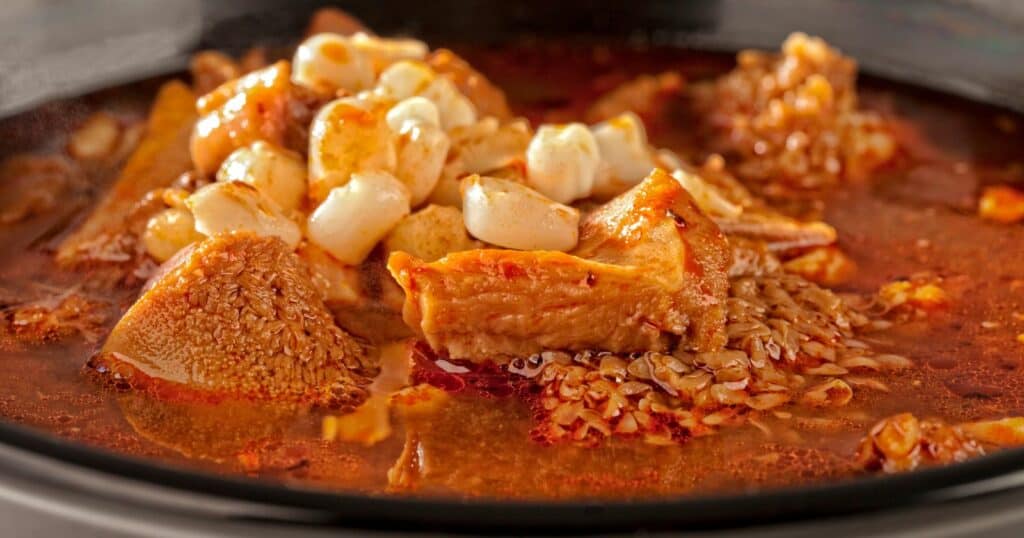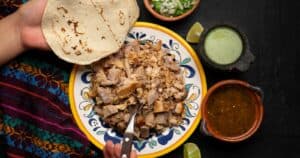Hey there! Have you ever noticed that delicious Mexican food like tacos, burritos, or nachos sometimes leaves your stomach feeling upset? You’re not alone. While Mexican cuisine is incredibly tasty, it has a reputation for causing digestive issues like gas, bloating, heartburn, and even diarrhea for some people.
In this article, we’ll walk through the most common reasons why Mexican food can wreak havoc on your stomach. We’ll also share smart tips for how to continue enjoying your favorites without the painful aftermath. Let’s dig in!
Spicy Ingredients Are Common Culprits
One of the biggest reasons Mexican food can cause stomach discomfort is the liberal use of fiery spices and chilies. From hot sauce to salsa, many Mexican dishes are loaded with flavorful but brutal seasonings like:
- Chili peppers
- Hot sauce
- Salsa
- Cayenne pepper
- Chili powder
- Jalapeños
- Habanero peppers
For those with sensitive stomachs, these zesty ingredients can be hard to handle! Spicy foods tend to increase stomach acid production. All that extra acid can lead to:
- Heartburn
- Indigestion
- Abdominal pain
- Diarrhea
The spicier the food, the more likely it is to burn not only your taste buds but also your digestive tract. No bueno!
How To Prevent Discomfort from Spicy Foods
Luckily, avoiding a Mexican food gut bomb doesn’t mean sacrificing all the delicious flavors. Try these tips and tricks:
- Request milder versions of dishes so you control the
spice level. Ask for salsa, tacos, enchiladas etc. to be made with less heat. - Avoid menu items with names that suggest extreme spiciness, like “Diablo” or “Inferno.” Not worth the pain!
- Pick dishes without hot sauces and salsas. Try fajitas, carnitas or ceviche that don’t rely on that extra
spice kick. - Have antacids on hand. Pop some Tums or another over-the-counter antacid if you feel heartburn coming on.
- Drink plenty of water with meals to dilute stomach acid.
With a few minor adjustments, you can enjoy all that delicious Mexican flavor without the searing stomach pains.
Indigestible Ingredients Can Also Cause Problems
It’s not only spicy seasonings that can lead to Mexican food hurting your stomach. Certain notoriously hard-to-digest ingredients commonly used in Mexican cooking can also cause tummy troubles.
Tripe

Tripe is beef stomach lining. It’s super chewy and naturally tough to break down during digestion.
Tripe is often found in menudo, a traditional Mexican soup. Because it’s so hard to digest, tripe is known to cause uncomfortable gas, bloating, and stomach pain.
Beans
Another culprit? Beans! Refried beans, black beans, pinto beans…legumes are used heavily in Mexican cuisine.
While beans provide lots of fiber, the natural sugars found in most varieties are difficult for some people to properly digest. This can lead to excessive gas, diarrhea, and other unpleasant digestive side effects.
How To Handle Problem Ingredients:
If beans or tripe spell disaster for your digestive system, try these fixes:
- Skip the tripe if menudo or other dishes contain it.
- Limit bean portions. Eat small amounts of fiber-rich beans at first to see if your body handles them okay.
- Use Beano. This over-the-counter supplement helps your body break down the sugars found in beans to reduce gas.
- Try probiotics. They can improve your ability to digest tougher ingredients like beans and tripe.
Contamination Risks With Certain Foods
Food poisoning is another common culprit behind Mexican food attacking your stomach. Certain ingredients are more prone to contamination if not handled properly.
Undercooked Meat and Eggs
Raw or undercooked beef, chicken, and pork can contain nasty bacteria that causes food poisoning. Runny eggs can also harbor dangerous salmonella.
Consuming undercooked animal products may lead to violent vomiting, diarrhea, and severe abdominal cramping. No one wants that!
Raw Produce
Fruits and veggies like cilantro, tomatoes and lettuce can pick up pathogens if washed in unclean water. This is especially concerning for produce eaten raw, like pico de gallo or guacamole.
Raw Seafood
Untreated raw seafood like oysters may contain bacteria or viruses that wreak havoc on your digestive system. We’re talking about violent nausea, horrible stomach pains, and explosive diarrhea.
How to Prevent Food Poisoning
You can take steps to avoid getting food poisoning when eating Mexican food:
- Only eat at highly rated restaurants known for fresh, high-quality ingredients. Check reviews!
- Ensure eggs and meat are cooked thoroughly. Send anything underdone back to the kitchen.
- Avoid uncooked items like ceviche if you have a sensitive stomach.
- Use caution with street vendors where ingredient handling is questionable.
Individual Sensitivities Can Play a Role
Your unique digestive system may simply be extra sensitive or intolerant to some ingredients commonly used in Mexican cooking:
- Onions, garlic, peppers, chili powder
- Beans, corn, grains
- Dairy like cheese, cream, sour cream
- Fried or fatty foods
- Alcoholic drinks like margaritas
- Caffeinated drinks like coffee
If your body lacks the enzymes needed to properly break down these foods, they can cause major stomach bloating, gas, diarrhea and abdominal cramping. Everyone’s digestive system is different!
Tips For Handling Sensitivities
If certain foods don’t sit right in your stomach:
- Try an elimination diet to pinpoint problem ingredients
- Take digestive enzymes to improve breakdown of trigger foods
- Request substitutions to avoid individual intolerances
- Limit portions of unfriendly foods
When To See A Doctor
In most cases, stomach troubles caused by Mexican food will resolve in a day or two. But if you experience severe abdominal pain and diarrhea lasting longer than 3 days, it’s smart to call your doctor.
You should also seek medical care immediately if you notice:
- Blood or mucus in stool
- Fever over 101°F
- Signs of dehydration like dizziness or dark pee
- Inability to keep any food or liquid down
These red flags could indicate a more serious health condition requiring treatment, like appendicitis or inflammatory bowel disease.
Tips To Keep Enjoying Mexican Cuisine
Now you know why Mexican food can sometimes cause stomach cramps, diarrhea, and other bummers. But there’s no need to cross these flavors off your menu for good. With the right precautions, you can keep enjoying tacos, enchiladas and more without the pain.
Choose Milder Dishes
Opt for naturally less spicy items like:
- Fajitas
- Carnitas
- Ceviche
- Grilled fish or chicken
Modify Spicing
Ask for dishes to be prepared:
- With mild salsas and sauces
- With less or no chili peppers
- With only mild chili powder
Watch Ingredient Portions
- Limit bean or dairy portions
- Avoid tripe
- Stick to fully cooked eggs and meat
Take Digestive Aids
Have things like probiotics, Beano, or antacids on hand to help ease digestion.
With a few simple precautions, you can keep enjoying all the bright, fresh flavors of Mexican food without the stomach somersaults! Let us know if these tips help make fiestas fun again for your digestive system. Now go and taco ’bout a good meal!





